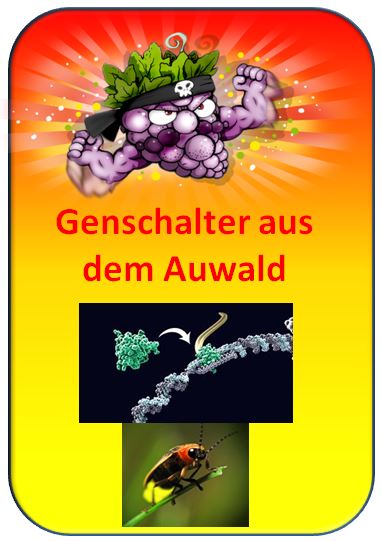2015-11 Novel Immunity Switch Discovered in the European Wild Grape
What is the topic?
The Botanical Garden of the KIT has established a genetic treasure unique in Europe: a complete genetic copy for the biodiversity of the German population of the European Wild Grape (Vitis sylvestris). This ancestor of our cultivated grape is almost extinct - the last viable population grows on the peninsula of Ketsch at the Rhine between Karlsruhe and Mannheim and in frame of a conservation project, we had collected cuttings, propagated them in the garden and brought them back to the wild in the alluvial forest (more...).
When we analyzed this collection, it turned out to harbour interesting resistance against several diseases. This could be used to breed a new generation of grapes that due to their better immunity do not require the conventional very intensive chemical plant protection. In frame of the transnationalen research network BACCHUS - Research for Sustainable Viticulture we had succeeded, together with colleagues of INRA Colmar and DLR Neustadt to identify one of the causes for this improved immunity (). We were able to show that some of these wild grapes very efficiently produce resveratrol and viniferin. These compounds suppress the growth of microorganisms, but are harmless for humans - in contrary: they even can prevent coronary diseases.
What is our new discovery?
We have now achieved one step ahead: in cooperation with the university of Mainz the genome of one of our immune wild grapes was sequenced. This led to the discovery of a novel DNA stretch that is absent from cultivated grapes. This DNA stretch is located in a control sequence of a gene switch called MYB14. What is switched on by this switch? The gene for stilbene synthase, a key enzyme for the synthesis of defence compounds. To test, whether the change in MYB14 is really the cause for the more efficient immunity of the wild grapes, we inserted these control sequences (so called promoters) in front of the gene for luciferase and shot this construct into living cells of grapevine by gold particle bombardment. Luciferase is the enzyme causing the luminescence of the firefly. When now our control sequence becomes activated, these cells will start to glow and by means of a luminometer, we can measure, how strongly they glow (in other words: how strongly the gene is activated). Using this system we were now able to ask, how immunity is activated: we found that the gene version from the wild grape was activating immunity four times stronger than the version from the cultivated grape. Moreover, we were able to dissect the early signals that activate immunity. We found out that
- first calcium channels in the membrane are opened,
- then calcium enters the cell and activates a MAP-kinase cascade (these are enzymes conferring phosphate groups as signal to other enzymes),
- in parallel, the enzyme NADPH oxidase is activated in the membrane,
- which will generate super oxide, a member of the reactive oxygen species,
- calcium and super oxide cooperate to activate the formation of jasmonic acid (the "plant adrenalin"),
- jasmonate and the MAP-kinases activate then the MYB14 gene,
- the MYB14 gene produces active MYB14 protein,
- the MYB14 protein binds to the control sequence of gene for stilbene synthase,
- the enzym stilbene synthase is made and generates the stilbenes resveratrol and viniferine that will kill the intruder.
What can we do with this knowledge?
When humans, around 8000 years ago in Georgia, domesticated wild grapes, a long history of first unconscious, later more targeted, modification initiated: The berries became larger and sweeter, the growth of the plant was accelerated. But everything has a price: this price was a far-ranging loss of the natural immunity in our cultivated grapes. This loss is expensive: viticulture usually requires more than 10 treatments with chemical plant protectants per season. This is not only expensive but also puts a heavy load on the environment. Can we give the lost immunity back to our cultured grapes? For this, we might simply cross cultivated and wild grapes. But then we would also get back many traits that are not desired - small and sour berries, slower growth, or the split into two genders (wild grapes are diecious, there are male and female plants). When we were able to search out from the progeny of such a cross a plant, which only adopted the immunity from the wild grapes, but would inherit all other properties from the cultivated parent, we would win. Of course, this is not possible in one step, but by several rounds of backcrossing of the hybrid with cultivated grapes it should be possible to generate such plants. However: how can we locate this miracle grape amont the numerous offspring. Well: we know the molecular nature of the immunity switch. This allows to design molecular probes that will locate by a Polymerase-Chain Reaction (PCR) the needle in the haystack. This approach is called molecular breeding and our discovery brings us, for the first time, into a position, to go for this path.
Publication
120. Duan D, Fischer S, Merz PR, Bogs J, Riemann M, Nick P (2016) An ancestral allele of grapevine transcription factor MYB14 promotes plant defence. J Exp Bot, 10.1093/jxb/erv569 - pdf

